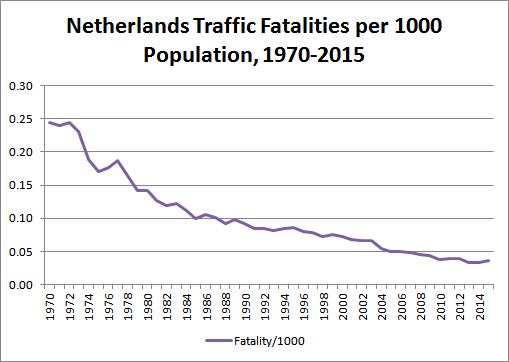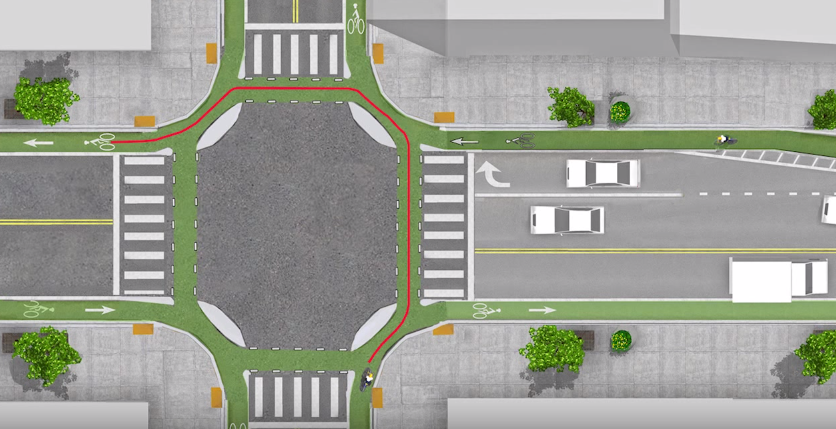Starting with Bay Street, let us use safe intersection design so that all people in Hamilton can also safely travel by bicycle.
By Kevin Love
Published June 21, 2017
Intersections are the most dangerous part of roads in Ontario. Page 53 of the Ontario Road Safety Annual Report 2014 [PDF] reports that 39.9 percent of deaths and a whopping 61.3 percent of personal injuries occur at intersections or related to intersections.
In 2014, the last year for which these statistics are available, there were 160 deaths and 19,905 personal injuries in Ontario caused by crashes at or related to intersections.
So how do the Dutch apply the principles of Sustainable Safety [PDF] to intersections? For major roads, a grade separated roundabout is the safest design.
But how about city streets with a level crossing?
Safe intersections for these city streets have two key features:
Right now in Hamilton, what little protection that cyclists have is taken away right where it is needed the most: at intersections. But in The Netherlands, a concrete "safety island" is used to provide protection in intersections right up to the actual point of crossing.
Here is a two minute video that describes how this works. Note how the two key safety features are implemented without any requirement for additional street space.
Now that we have seen the theory of safe intersection design, here is a four minute video showing several real-life examples of safe intersections in action.
As is emphasized in the videos, the key safety feature is the concrete safety island. This safely separates cycling and motor vehicle traffic and requires crossings to be made with good sightlines at a safe 90 degree angle.
Here is a slightly longer five-minute video that explains why these safety features are so important.
As is emphasized in the videos, there is nothing new or experimental in this intersection design. It is a standard Dutch design whose widespread implementation has played a vital role in the steadily increasing safety of streets in The Netherlands.

Chart: Netherlands Traffic Fatalities per 1000 Population, 1970-2015 (Data sources: OECD Road Accidents, Netherlands Central Bureau of Statistics)
Last June 7, the City of Hamilton presented its proposed new design for Bay Street to the Hamilton Cycling Committee.
Overall, this design is a big step forward. However, members of the Committee had serious concerns with the proposed design of the intersections, particularly with the intersection of Bay and Cannon streets.
Since the implementation of the Cannon Street Cycle Track in 2014, the volume of bicycle traffic on that street has been steadily increasing.
The problem with the Bay Street proposed intersection design is that it has bicycle and motor vehicle traffic unsafely "weaving" through each other before the intersections.
This creates a truly frightening situation in which motor vehicle and bicycle traffic is suddenly mixed with each other in the most dangerous place to do so, at an intersection.
This proposed design has been previously tried in the USA, where it turned out to be a dangerous failure.
One of the Committee members, Ann McKay, said: "I would not let my child ride a bike like that with car traffic."
My mother's opinion is similar: "At my age, I am not going to play tag with two-tonne lethal weapons."
Since Central Public School is right on Bay Street, it is important that parents are confident in their children safely riding to school. This design fails to achieve that goal.
In The Netherlands, everyone cycles because the infrastructure provides for safe cycling from the ages of 8 to 80.
Starting with Bay Street, let us use safe intersection design so that all people in Hamilton can also safely travel by bicycle.

Dutch intersection design guideline (Image Credit: still from linked video)
By OliverV (registered) | Posted June 21, 2017 at 11:11:59
Is the proposed intersection design at Bay and Cannon posted anywhere? The city's page on the Bay Street bike lanes does not show anything, but sounds like the conversion to two way facility would be confusing for everyone.
https://www.hamilton.ca/streets-transpor...
Comment edited by OliverV on 2017-06-21 11:13:09
By KevinLove (registered) | Posted June 21, 2017 at 14:25:46 in reply to Comment 121617
No. As a matter of City policy the design drawings are not posted on the City's website or anywhere else. This is true not only of Bay Street, but of all proposals for changes to the City's street network.
If you believe that this practice fails to conform to the City's policies concerning transparency and openness, I recommend that you contact your ward Councillor.
You must be logged in to comment.
There are no upcoming events right now.
Why not post one?